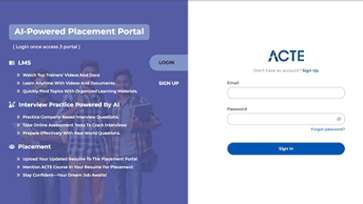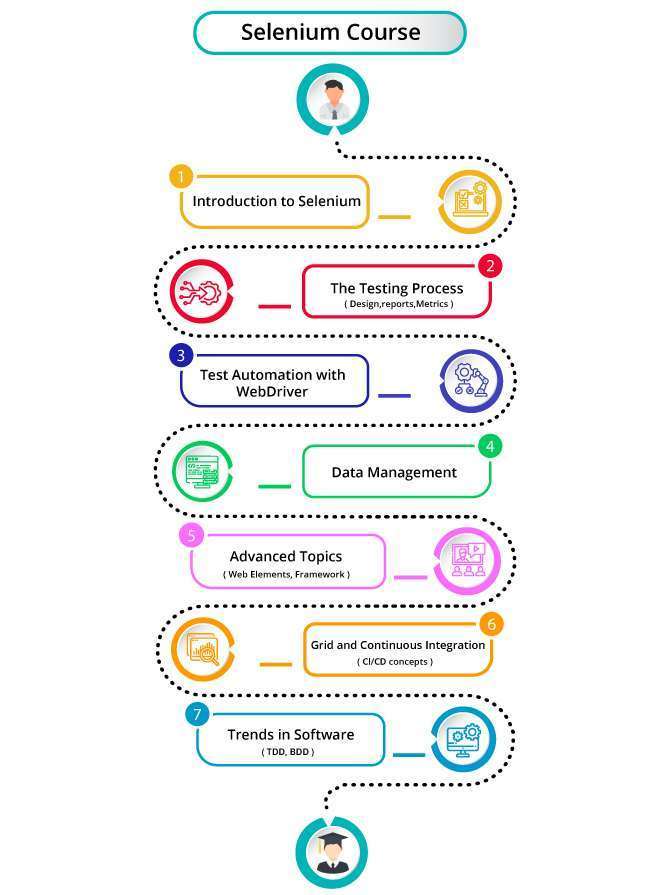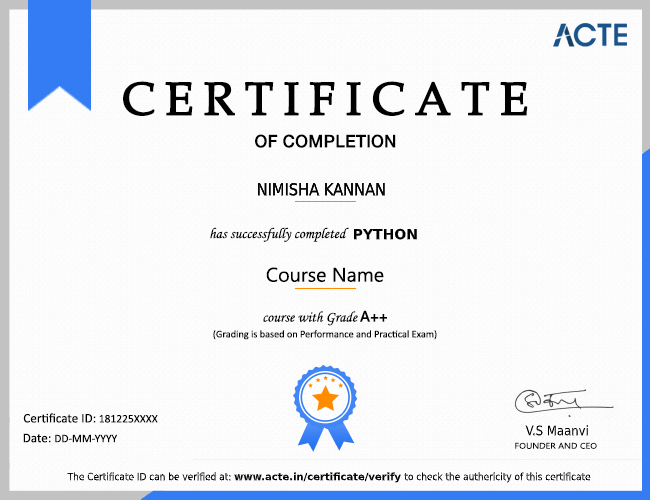Selenium Training Course Content
Syllabus of Selenium Course in Chennai
Module 1 : Introduction
- What is automation testing
- Difference between Manual & Automation lesting
- When to go for Automation
- Advantages of Automation
- Licensed Automation Tools
- OpenSource Automation Tools
Module 2 : Introduction of Selenium
- Overview of Selenium
- Different Selenium Components(Selenium.IDE, WebDriver, Selenium GRID)
- Differences between Selenium and other Tools
Module 3 : Configuring Eclipse IDE
- Installation of Java
- Installation Eclipse IDE
- How to create new java project
- How to create a new java class
- Compiling and Running java class
- Analyzing the results of java program
Module 4 : Learning Java
- Introduction to Java programming
- Primitive and Non-Primitive Data types
- Operators in Java
- Wrapper Classes
- lypes of Variable (Local, Instance and Static Variables)
Module 5 : Conditional Statements
- If else condition
- Nested If Else Condition
- Switch case statement
- Examples for all the above conditions
Module 6 : Loop Statements
- While loop
- Do while
- For loop.
- For each loop
- Examples for all the above loops
Module 7 : Arrays
- What is an Array?
- Type of Arrays
- Working with Single Dimensional and Multi-Dimensional Arrays
- Copying Arrays with Clone() and arraycopy()
Module 8 : Packages, Classes and Objects
- What are Packages
- How to create Classes .Objects and Object References
- Working with Constructors
- Using Methods(instance,static)
- Access Modifiers (private, default, protected and public)
- Method arguments call by value and call by reference
- How to write user defined methods
Module 9 : Interface& Abstract Class
- How to define Interface
- How to implement Interface
- How to define Abstract Class
- Abstract method vs. Concrete method
- Interface vs. Abstract class vs. Concrete Class
- Implements vs. extends
Module 10 : Inheritance
- What is Inheritance and Why to use Inheritance?
- Single Level Inheritance, Multi-Level Inheritance, Multiple Inheritances (Through Interface)
- super keyword
- this keyword
- Composition / Aggregation
- Inheritance (Is a Relationship) vs.composition (Has a Relationship)
Module 11 : Polymorphism
- What is polymorphism?
- Compile time Polymorphism
- Method overloading
- Constructor overloading
- Runtime Polymorphism
- Method Overriding
- final keyword
Module 12 : Exception handling
- What are exceptions and errors?
- Checked Exception or Compile time Exception
- Unchecked Exception or Runtime Exception
- How to handle exceptions in the program!
- Using try and catch blocks
- Using of throw
- Using of throws
Module 13 : Collections
- Overview of Collections API
- Arrays vs Collections
- List, Set, Map interfaces
- Using ArrayList Class
- Working with elements of a Collection
- Examples for all the above concepts
Module 14 : Database Connection (JDBC)
- How to configure MySQL database
- How to configure with Eclipse
- Connection Interface Commands
- Statement Interface Commands
- ResultSet Interface Commands
- How to execute query
Module 15 : Debug Java code / Scripts in Eclipse
- Understanding Debug
- Using Breakpoints.
- Verify the values during debug
- Using step over, step into
Module 16 : Selenium WebDriver
- Features and Limitations of Selenium Webdriver
- Configure Selenium with Eclipse IDE(Adding selenium Libraries)
- Configure Selenium with Chrome,
- Firefox Driver, IE, Safari, Operabrowsers
- WebDriver Interface
- ChromeDriver, FirefoxDriver, InternetExplorer Driver,Edge Driver classes
- Browser Commands
- Navigation Commands
- Handling Cookies
Module 17 : Locators
- Object Identification
- findElement and findElements
- Different types of Locators
- Xpath,relativeXpath,AbsoluteXpath,cssSelector
- How to build dynamic Xpath
- Identifying Objects using Xpath and cssSelectors
- How to use Regular Expressions in Xpath and CssSelectors
- How to configure ChroPath •Html Tags and DOM structure
Module 18 : TextField, Checkbox, RadioButtons, Links and Buttons
- Handling TextField and Text Area
- Handling Checkbox’s
- Handling RadioButtons
- Handling Links and Buttons
- WebElement Interface methods
Module 19 : Dropdowns, Web Tables, Calendar
- Handling dropdowns/listboxesi
- Select Class methods
- Working with Dynamic Web Table Elements
- Extracting data from WebTable’s
- Custom methods for WebTable’s
- Select date from calendar
Module 20 : Alerts,Frames, Windows
- Handling alerts
- Alert interface methods
- Handling Frames /IFrames
- Handling Nested Frarnes
- How to handle multiple browsers or Tabs
- TargetLocator interface methods
Module 21 : Actions Class, TakesScreenshot, JavaScript Executor
- Mouse Events
- Click, doubleClick, contectClick, dragAndDrop, clickAndHold,release
- Keyboard Events
- How to scroll page
- Capture screenshot
- How to execute JavaScript
Module 22 : Synchronization
- How to use implicitWait, pageLoad T imeout, setScript Timeout
- How to use ExplicitWait
- How to implement WebDriverWait
- What are different ExpectedConditions and how to use
- How to implement FluentWait
Module 23 : Miscellaneous
- Headless browsers
- Handling Notifications
- Handling Auto Suggestions
- Highlight objects
- Scroll into view
- How to find broken links
- Different Selenium Exceptions
- Capture screenshot of entire page
Module 24 : Auto It, Sikuli, Robot
- Configure Sikuli with Selenium
- File Upload/Download with Sikuli
- Configure Auto It with Selenium
- File Upload/Download with Auto IT
- File Upload/Download with Robot
Module 25 : Apache POl
- Configure Apache POI with Eclipse
- Workbook, Sheet Row ,Cell Interfaces methods
- HSSFWorkbook, HSSFSheet, HSSFRow, HSSFCell methods
- XSSFWorkbook, XSSFSheet, XSSFRow, XSSFCell methods
- How to read data from Excel file(XLS or XLSX)
- How to write data to Excel file(XLS or XLSX)
Module 26 : TestNG
- TestNGFeatures
- Configure TestNG with Eclipse
- TestNG Annotations
- Integrate Selenium Scripts with TestNG
- Create TestNG.xml file
- Assert methods
- Hard Assert vs. Soft Assert
- Cross browser testing
- How to use DataProvider
- Reporting Results
- Listeners
- Sequential Execution vs. Parallel Execution
- How to create batch file
- Extended Reports
Module 27 : Maven
- What is maven
- Installing Maven in Local Machine
- Creating Maven project in Eclipse
- Understanding of POM .xml
- Maven Integration with TestNG
- Maven Lifecycle
- Executing Scripts Using Maven build tool
- Advantages Maven Build Tool
Module 28 : Jenkins
- Overview of Jenkins
- Installing Jenkins
- Configure Maven project in Jenkins
- Configure Non Maven project in lenkins
- Creating Jobs in Jenkins
- Scheduling lobs for timely Execution
- Integration with Selenium Scripts and Running Scripts
- Configure Email notification in Jenkins
Module 29 : Selenium Grid
- Overview of Selenium Grid
- Remote WebDriver and Desired Capabilities class
- Configuring Hub
- Configuring Node
- Running scripts on Remote system
- Run Selenium scripts in parallel on Remote system
Module 30 : GitHub & Git
- How to create GitHub Account
- Configure Git and GitHub with Eclipse
- Git & GitHub Commands
- Integrate with Framework
Module 31 : Cucumber
- Overview of BDD and Cucumber
- How to install and setup Cucumber with Eclipse
- Overview of Gherkin keywords
- How to create Feature file
- How to generate Step Definition file
- How to integrate Cucumber with Selenium WebDriver
- JUnit Test Runner Class
- Data Driven esting in Cucumber
- Configure Cucumber with Maven and Jenkins
- How generate Reports in Cucumber
Module 32 : Katalon Studio
- Download and Install Katalon Studio
- Configuring Katalon Studio for Web Applications
- How to create TestCase and TestSuite
- How to create Object Repository
- Create Automation Script using Record and Playback, Manual Mode, Script Mode
- How to integrate with other environments
Module 33 : Appium
- Introduction to Mobile Automation &Appium
- Installation of Android SDK on Windows OS
- Installation of Appium on Windows OS
- Configure Appium Client libraries
- Configuration of Environment variables
- How to use UIAutomator Viewer
- How to use Appium Inspector
- Different types of Locators
- Mobile Web App Automation
- Native App Automation
- Hybrid App Automation
- Configuring & executing scripts on Emulator and Real Device































